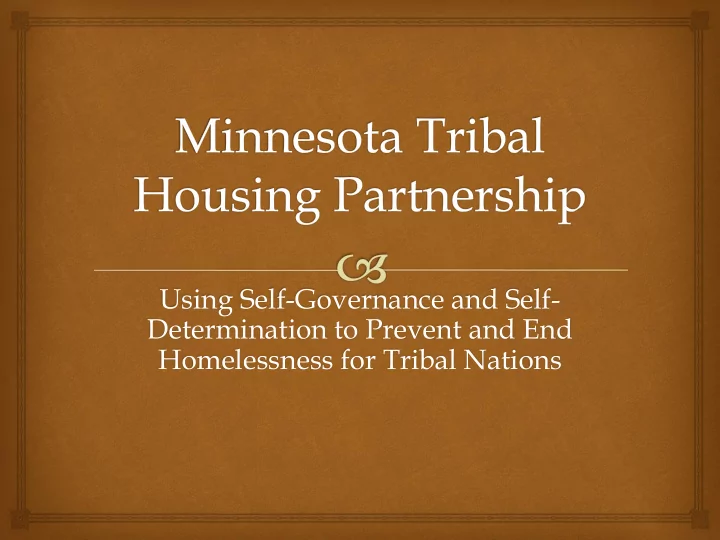

Using Self-Governance and Self- Determination to Prevent and End Homelessness for Tribal Nations
Introductions
Facts and Information Who is an American Indian? Generally speaking – a person meeting the following qualifications: Someone who has American Indian blood – Ancestors must have lived in North American pre-European contact or “discovery” Recognized as American Indian by members of his/her tribe or community (blood quantum or lineal descent classification)
Some Truths and Misunderstandings Most of us in America live with enormous misunderstandings about American Indians Little to no education about the first or Indigenous people Media shapes perceptions People or culture either romanticized or demonized
Historical Facts: Treaties Indigenous, Native American, American Indian people were the first people of this nation Dakota and Ojibwe people were among the first people to Minnesota long before it was called Minnesota, with Dakota people residing here the longest Treaties are agreements between self-governing, or sovereign nations, and are still in effect today. American Indian-U.S. treaties still matter today.
“Treaties are agreements between self - governing, or sovereign nations. Native Nations existed long before the formation of the United States. European powers recognized the sovereign status of Native Nations when they made treaties with us, as did the United States. Article 1, Section 8, of the U.S. Constitution recognizes Indian Tribes as distinct sovereign entities on par with foreign nations.” Quote by Kevin Leecy, Chairman of the Bois Forte Band of Ojibwe and Chairman of the Minnesota Indian Affairs Council
More History: Assimilation Campaign Boarding Schools Reservations
U.S. Authority Henry Richard Pratt Our goal is to kill the Indian in order to save the man.”
Loss of Language and Culture: Carlisle Indian Industrial School
Carlisle Indian Industrial School 1879-1918 It was not about GIVING an education, but TAKING AWAY tribal culture Carlisle military barracks were converted to a school School was industrial Boys dug ditches, performed manual labor half the day while girls sewed, cleaned and cooked half the day
Physical Make-over
Historical Facts on Destruction and Loss Indian Land Before Colonization
Map of Tribal Lands Now
Native Nations in Minnesota
Minnesota Indian Population Where do all the Indians live? 22 percent on Indian Reservations 20 percent in Adjacent counties 32 percent live in Hennepin and Ramsey County 24 percent live elsewhere in the state Indians, Indian Tribes and State Government, 2007 4 th Edition, 2000 Census information
Creation of MN Tribal Housing Collaborative Reason Formed Members of Collaborative
Mission of the Collaborative The mission of the collaborative: is While honoring tribal sovereignty, we will work together to maximize resources and obtain sustainable housing options through innovative efforts of our tribal governments and communities.
Highlights of the Collaborative Meetings Rotate Everyone is an equal partner Tribal Sovereignty is recognized & Honored Make the invisible visible Ensure all voices heard Policies established
Solutions Focused Work with the Continuum of Cares Work on Coordinated Entry Wilder Reservation Survey Work on creating access to funding
Housing Funding Chart White Earth Mdewakato Leech Lake Shakopee Mille Lacs Bois Forte Fond du Red Lake Grand Portage Upper Lower Prairie Island Sioux Sioux Lac n Emergency Services xx Program Emergency Solutions Grant Transitional Housing Program Homeless Youth Act Long-term Homeless Supportive Services Group Residential Housing MN Supplemental Aid: Housing Assistance SSI/SSDI Outreach, Access and Recovery Family Sub Homelessness grantee Sub grantee Prevention and Assistance Program Housing and Urban Development
State Perspective Why attend the collaborative meetings
Wilder Reservation Survey Why is there a Wilder Reservation Survey Highlights of the 2015 Wilder Reservation Survey How Tribes use the survey
What % of respondents were doubled up?
Doubled up population Long-term Homeless for 1+ years 73% Crowded Highly mobile Living in overcrowded 72% spaces (>1 PPR) Moved 3+ times in the 63% past year
Doubled up population Long-term Homeless for 1+ years 73% Crowded Highly mobile Living in overcrowded 72% spaces (>1 PPR) Moved 3+ times in the 63% past year
Doubled up population Two-fifths have Slept in a location recently experienced unsuitable for 40% HUD definition of habitation (past 6 months) homeless Over one-third are Cannot/not sure if unstable in their they can remain 36% doubled-up doubled up for another month arrangement
How much space do families need?
Housing needs for families experiencing homelessness on Minnesota’s reservations Single room studio or efficiency, 2% Four or more One bedroom, bedrooms, 13% 7% Three Two bedrooms, 36% bedrooms, 41%
Your study tables
Statewide study tables (mnhomeless.org)
Employment rates Homeless in greater MN 32% Homeless in MN 30% Homeless and near-homeless 23% on reservations
Heroin use during the past 30 days Homeless in MN, 2015 1% Homeless in Greater MN, 2015 1% Homeless and near-homeless 2% on reservations, 2012 Homeless and near-homeless 6% on reservations, 2015
Myths and Facts Because of casinos American Indians receive money from the casinos Being doubled up is not considered homeless, it is a cultural value American Indians wear costumes to go to powwows Tribal nations don’t require college education for those who work in social services AI/AN people have distinguishing physical characteristics, and you can identify them by how they look. MN has 11 federal recognized tribal nations American Indians only reside on Reservations American Indian and Alaskan Native people are spiritual and live in harmony with nature. Fry bread is not a traditional food Until recently, the tribes were not eligible applicants for LTH and FHPAP funding
Questions and Comments
Recommend
More recommend